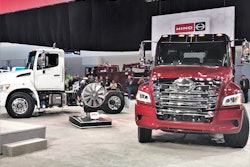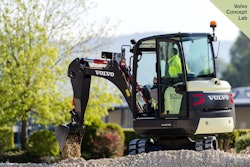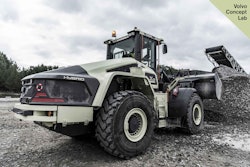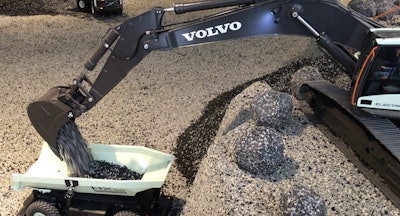 Volvo Construction Equipment demonstrates its electric site quarry concept with RC scale models.
Volvo Construction Equipment demonstrates its electric site quarry concept with RC scale models.Volvo Construction Equipment, which had announced its electric site quarry initiative at its Xploration Forum in September 2016, is now gearing up for a 10-week field test this fall.
The company says its building a fleet of eight prototype HX2 autonomous electric carriers to take part in the test, which will also include its LX1 hybrid wheel loader and an EX1 cable-connected excavator.
Volvo is partnering with Swedish construction giant Skanska Sweden, the Swedish Energy Agency and two Swedish universities on a $30 million project aimed at creating an electrified quarry where not only carbon emissions are reduced by up to 95 percent, but also the total cost of quarry operating costs are reduced by 25 percent.
The electric site project has developed into a rethinking of quarry processes and layout, particularly in the ways aggregate is handled. Instead of using articulated dump trucks or rigid frame haulers to move aggregate from Point A to Point B, the electric site concept will use the autonomous 15-ton HX2 carriers to load crushed aggregate directly from the crusher.
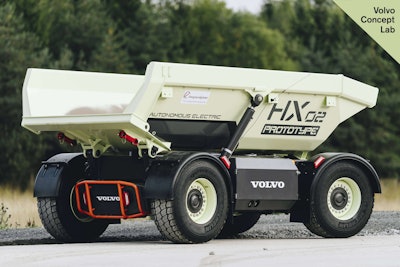 HX2 autonomous carrier
HX2 autonomous carrierThe HX2 prototype carrier is the latest iteration of the HX1 revealed at the Xploration Forum.
Volvo now says its second-generation HX2 concept machine is “fundamentally different” from the initial HX1. It now incorporates shared technologies and components from the Volvo Group, including electric motors, batteries and power electronics. “Integrating a completely new drivetrain was crucial to take full advantage of the groundbreaking electromobility improvements that are happening inside the Volvo Group,” says Uwe Muller, Volvo CE’s chief project manager for the electric site projects. In addition, the HX2 now has a vision system, with which the machine can detect humans and obstacles.
The LX1 hybrid wheel loader prototype has gone through its own testing in the United States at two Waste Management sites in California. Last year, Volvo announced that after six months of testing, the LX1 loader achieved up to 50 percent fuel efficiency improvement over a comparison machine in certain tests, well exceeding the 35 percent goal it set for the project.
John Meese, Waste Management’s senior director of heavy equipment, continues to be enthusiastic a year after the 2017 test. “We had the ability to dial down the torque and keep the wheels from spinning on slippery surfaces,” he told editors gathered at a press event last week. “We also wanted to raise the bucket quickly but control the dumping action, and we were able to ask Volvo to increase the speed up cycle and slow the speed of the dump cycle so that we can meter the material in. It was just a few keystrokes. That was amazing.”
Volvo’s 70-ton EX1 cable-connected prototype excavator will also play a role at the quarry. The machine still has a diesel engine, which can be used to reposition the unit in the quarry, a feature that will only be used a small percentage of its total hours.. “For 95 percent of the time, it’s loading a crusher,” says Scott Young,Volvo CE’s electromobility director. “During that time, it’s connected to the grid, coming from Skanska’s wind-generated power.”
Volvo built the EX1 by using a Volvo EC750 and adding an electric motor to the diesel-powered machine. Fitting the new components into the machine without increasing its size required a “significant amount of repackaging work,” Muller says. “However, in terms of the operator interface and controls, nothing has changed.”
Muller says the electric site research project is “a step towards transforming the quarry and aggregates industry. We are combining intelligent machines, automation and electromobility as a door opener to developing complete new solutions to meet customer needs.”
Watch the video below to see Volvo’s demonstration of the electric site concept using models.





